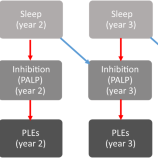
Articles
-
May 7, 2024 |
nature.com | Julien Ouellet |Mohammad H. Afzali |Stéphane Potvin |Patricia Conrod |Sima Nourbakhsh |Roxane Assaf
Adolescence is a key period for neurocognitive maturation where deviation from normal developmental trajectories may be tied to adverse mental health outcomes. Cognitive disruptions have been noted in populations at risk for psychosis and are known to accompany periods of sleep deprivation. This study aims to assess the role of cognition as a mediator between sleep disruptions and psychosis risk. A cohort of 3801 high school students (51% female, mean age = 12.8, SD = 0.45 years) was recruited from 31 Montreal high schools. Measures of sleep, psychotic-like experiences, inhibition, working memory, perceptual reasoning, and delayed recall were collected from participants on a yearly basis over the five years of their high school education. A multi-level model mediation analysis was performed controlling for sex and time squared. Response inhibition was shown to be associated with, and to mediate (B = −0.005, SD = 0.003, p = 0.005*) the relationship between sleep disruptions (B = −0.011, SD = 0.004, p < 0.001*) and psychotic-like experiences (B = 0.411, SD = 0.170, p = 0.005*). Spatial working memory deficits on a given year were associated with a higher frequency of psychotic-like experiences that same year (B = −0.046, SD = 0.018, p = 0.005*) and the following year (B = −0.051, SD = 0.023, p = 0.010*), but were not associated with sleep disturbances. No significant associations were found between our variables of interest and either delayed recall or perceptual reasoning at the within person level. Findings from this large longitudinal study provide evidence that the association between sleep disruptions and psychosis risk is specifically mediated by inhibitory rather than general cognitive impairments. The association of spatial working memory, response inhibition, and sleep disruptions with psychotic-like experiences suggests that these factors may represent potential targets for preventative interventions.
-
Oct 23, 2023 |
nature.com | Julien Ouellet |Elroy Boers |Patricia Conrod |Mohammad H. Afzali |Jasmina Wallace
Previous longitudinal studies found significant associations between screen time and increase in attention-deficit/hyperactivity disorder (ADHD) symptoms, but the mechanisms mediating this association remain understudied. Thus, we used data from a 5-year population-based longitudinal cohort of nearly 4000 Canadian high school students, modeled using multivariate multilevel mediation, to investigate the association of screen time (i.e., social media, television, video games, computer use) with ADHD symptoms via different potential behavioral and neuropsychological mediators (i.e. impulsivity, response inhibition, working memory). We studied direct and indirect between-person, concurrent within-person, and lagged-within-person effects of screens on ADHD symptoms. Results showed that increases in screen time in a given year were associated with an exacerbation of ADHD symptoms within that same year (within-person association), over and above potential common vulnerability (between-person association). Impulsivity proved to be the most robust mediator in the association of screen time with ADHD symptoms at both between and within-person levels. Only social media use displayed a significant lagged-within-person association with ADHD symptoms mediated by impulsivity, indicating an enduring influence on behavior, which was further shown to be mediated by chained changes in response inhibition on a Go/No-Go task. These findings provide clinical implications of screen time and should be an important focus in the management and prevention of ADHD symptoms among adolescents.
Try JournoFinder For Free
Search and contact over 1M+ journalist profiles, browse 100M+ articles, and unlock powerful PR tools.
Start Your 7-Day Free Trial →